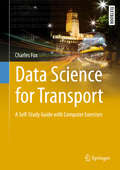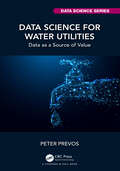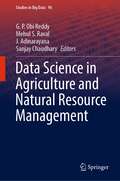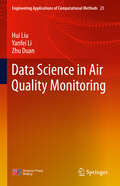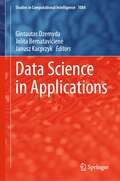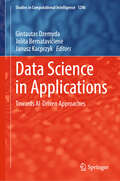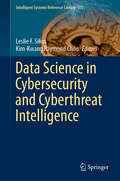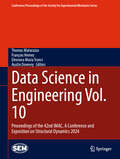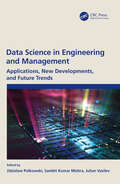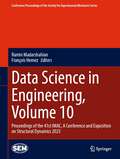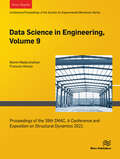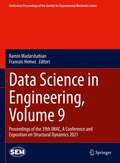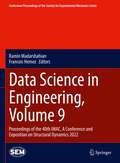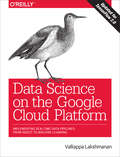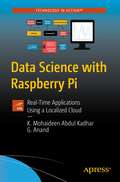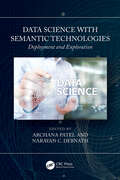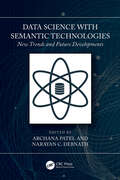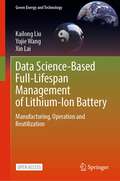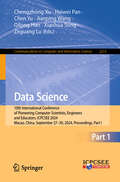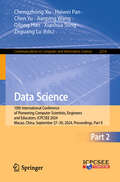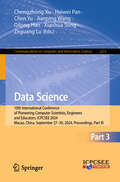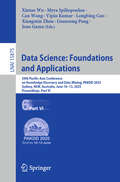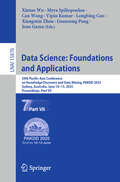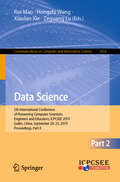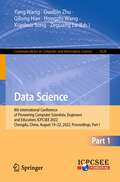- Table View
- List View
Data Science for Transport: A Self-study Guide With Computer Exercises (Springer Textbooks In Earth Sciences, Geography And Environment Ser.)
by Charles FoxThe quantity, diversity and availability of transport data is increasing rapidly, requiring new skills in the management and interrogation of data and databases. Recent years have seen a new wave of 'big data', 'Data Science', and 'smart cities' changing the world, with the Harvard Business Review describing Data Science as the "sexiest job of the 21st century". Transportation professionals and researchers need to be able to use data and databases in order to establish quantitative, empirical facts, and to validate and challenge their mathematical models, whose axioms have traditionally often been assumed rather than rigorously tested against data. This book takes a highly practical approach to learning about Data Science tools and their application to investigating transport issues. The focus is principally on practical, professional work with real data and tools, including business and ethical issues."Transport modeling practice was developed in a data poor world, and many of our current techniques and skills are building on that sparsity. In a new data rich world, the required tools are different and the ethical questions around data and privacy are definitely different. I am not sure whether current professionals have these skills; and I am certainly not convinced that our current transport modeling tools will survive in a data rich environment. This is an exciting time to be a data scientist in the transport field. We are trying to get to grips with the opportunities that big data sources offer; but at the same time such data skills need to be fused with an understanding of transport, and of transport modeling. Those with these combined skills can be instrumental at providing better, faster, cheaper data for transport decision- making; and ultimately contribute to innovative, efficient, data driven modeling techniques of the future. It is not surprising that this course, this book, has been authored by the Institute for Transport Studies. To do this well, you need a blend of academic rigor and practical pragmatism. There are few educational or research establishments better equipped to do that than ITS Leeds". - Tom van Vuren, Divisional Director, Mott MacDonald"WSP is proud to be a thought leader in the world of transport modelling, planning and economics, and has a wide range of opportunities for people with skills in these areas. The evidence base and forecasts we deliver to effectively implement strategies and schemes are ever more data and technology focused a trend we have helped shape since the 1970's, but with particular disruption and opportunity in recent years. As a result of these trends, and to suitably skill the next generation of transport modellers, we asked the world-leading Institute for Transport Studies, to boost skills in these areas, and they have responded with a new MSc programme which you too can now study via this book." - Leighton Cardwell, Technical Director, WSP."From processing and analysing large datasets, to automation of modelling tasks sometimes requiring different software packages to "talk" to each other, to data visualization, SYSTRA employs a range of techniques and tools to provide our clients with deeper insights and effective solutions. This book does an excellent job in giving you the skills to manage, interrogate and analyse databases, and develop powerful presentations. Another important publication from ITS Leeds." - Fitsum Teklu, Associate Director (Modelling & Appraisal) SYSTRA Ltd"Urban planning has relied for decades on statistical and computational practices that have little to do with mainstream data science. Information is still often used as evidence on the impact of new infrastructure even when it hardly contains any valid evidence. This book is an extremely welcome effort to provide young professionals with the skills needed to analyse how cities and transport networks actually work. The book is also highly relevant to anyone who will later want to build digital solutions to optimise urban travel based on emerging data sources". - Yaron Hollander, author of "T
Data Science for Water Utilities: Data as a Source of Value (Chapman & Hall/CRC Data Science Series)
by Peter PrevosThis addition to the Data Science Series introduces the principles of data science and the R language to the singular needs of water professionals. The book provides unique data and examples relevant to managing water utility and is sourced from the author’s extensive experience. Data Science for Water Utilities: Data as a Source of Value is an applied, practical guide that shows water professionals how to use data science to solve urban water management problems. Content develops through four case studies. The first looks at analysing water quality to ensure public health. The second considers customer feedback. The third case study introduces smart meter data. The guide flows easily from basic principles through code that, with each case study, increases in complexity. The last case study analyses data using basic machine learning. Readers will be familiar with analysing data but do not need coding experience to use this book. The title will be essential reading for anyone seeking a practical introduction to data science and creating value with R.
Data Science in Agriculture and Natural Resource Management (Studies in Big Data #96)
by Sanjay Chaudhary G. P. Obi Reddy Mehul S. Raval J. AdinarayanaThis book aims to address emerging challenges in the field of agriculture and natural resource management using the principles and applications of data science (DS). The book is organized in three sections, and it has fourteen chapters dealing with specialized areas. The chapters are written by experts sharing their experiences very lucidly through case studies, suitable illustrations and tables. The contents have been designed to fulfil the needs of geospatial, data science, agricultural, natural resources and environmental sciences of traditional universities, agricultural universities, technological universities, research institutes and academic colleges worldwide. It will help the planners, policymakers and extension scientists in planning and sustainable management of agriculture and natural resources. The authors believe that with its uniqueness the book is one of the important efforts in the contemporary cyber-physical systems.
Data Science in Air Quality Monitoring (Engineering Applications of Computational Methods #23)
by Hui Liu Yanfei Li Zhu DuanThis book presents a series of state-of-the-art methods for air quality monitoring in various engineering environment by using data science. In the book, the data-driven key techniques of the preprocessing, decomposition, identification, clustering, forecasting and interpolation of the air quality monitoring are explained in details with lots of experimental simulation. The book can provide important reference for the development of data science technologies in engineering air quality monitoring. The book can be used for students, engineers, scientists and managers in the fields of environmental engineering, atmospheric science, urban climate, civil engineering, traffic and vehicle engineering, etc.
Data Science in Applications (Studies in Computational Intelligence #1084)
by Janusz Kacprzyk Gintautas Dzemyda Jolita BernatavičienėThis book provides an overview of a wide range of relevant applications and reveals how to solve them. Many of the latest applications in finance, technology, education, medicine and other important and relevant fields are data-driven. The volumes of data are enormous. Specific methods need to be developed or adapted to solve a particular problem. It illustrates data science in applications. These applications have in common the discovery of knowledge in data and the use of this knowledge to make real decisions. The set of examples presented serves as a recipe book for their direct application to similar problems or as a guide for the development of new, more sophisticated approaches. The intended readership is data scientists looking for appropriate solutions to their problems. In addition, the examples provided serves as material for lectures at universities.
Data Science in Applications: Towards AI-Driven Approaches (Studies in Computational Intelligence #1206)
by Janusz Kacprzyk Gintautas Dzemyda Jolita BernatavičienėThis book provides a forum for presenting and discussing new and promising ideas in the broadly understood data science field and scope. Data science is a broad discipline. Related and partially overlapping fields are data mining, pattern recognition, neurocomputing, statistics, mathematics, data visualisation, databases, data processing, knowledge discovery in databases, big data analysis, computer science, cloud computing, machine learning, and artificial intelligence. Recent research has focused on unlocking the new possibilities of artificial intelligence, not only from a theoretical point of view but also from an applied perspective. In light of recent developments and trends in these fields, the topics covered in the book have been expanded and extended to include various aspects of artificial intelligence (AI), advanced data analysis, data analytics, machine learning, and multimedia, both from a theoretical and a practical application perspective. All of these are coming together, so we are seeing a variety of AI-driven approaches. This book contains 12 chapters by data science researchers. They are divided into &“AI-supported multimedia systems&” and &“Developments, challenges, and applications of advanced data analysis and machine learning.&” The first part of the book contains chapters that discuss various aspects of multimedia systems, notably text, voice, and image, in particular from the point of view of how new developments in AI, advanced data analyses, etc., can provide new, effective and efficient, tools and techniques, maybe even imply research and implementation breakthroughs. The second part of the book, &“Developments, challenges and applications of advanced data analysis and machine learning,&” is concerned with various aspects, problems, solutions, and applications for new sophisticated tools and techniques of data analyses, data analytics, and machine learning providing tools and techniques to take advantage of what is available in data.
Data Science in Cybersecurity and Cyberthreat Intelligence (Intelligent Systems Reference Library #177)
by Leslie F. Sikos Kim-Kwang Raymond ChooThis book presents a collection of state-of-the-art approaches to utilizing machine learning, formal knowledge bases and rule sets, and semantic reasoning to detect attacks on communication networks, including IoT infrastructures, to automate malicious code detection, to efficiently predict cyberattacks in enterprises, to identify malicious URLs and DGA-generated domain names, and to improve the security of mHealth wearables. This book details how analyzing the likelihood of vulnerability exploitation using machine learning classifiers can offer an alternative to traditional penetration testing solutions. In addition, the book describes a range of techniques that support data aggregation and data fusion to automate data-driven analytics in cyberthreat intelligence, allowing complex and previously unknown cyberthreats to be identified and classified, and countermeasures to be incorporated in novel incident response and intrusion detection mechanisms.
Data Science in Engineering Vol. 10: Proceedings of the 42nd IMAC, A Conference and Exposition on Structural Dynamics 2024 (Conference Proceedings of the Society for Experimental Mechanics Series)
by François Hemez Austin Downey Thomas Matarazzo Eleonora Maria TronciData Science in Engineering, Volume 10: Proceedings of the 42nd IMAC, A Conference and Exposition on Structural Dynamics, 2024, the tenth volume of ten from the Conference brings together contributions to this important area of research and engineering. The collection presents early findings and case studies on fundamental and applied aspects of Data Science in Engineering, including papers on: Novel Data-driven Analysis Methods Deep Learning Gaussian Process Analysis Real-time Video-based Analysis Applications to Nonlinear Dynamics and Damage Detection Data-driven System Prognostics
Data Science in Engineering and Management: Applications, New Developments, and Future Trends
by Zdzislaw PolkowskiThis book brings insight into data science and offers applications and implementation strategies. It includes current developments and future directions and covers the concept of data science along with its origins. It focuses on the mechanisms of extracting data along with classifications, architectural concepts, and business intelligence with predictive analysis. Data Science in Engineering and Management: Applications, New Developments, and Future Trends introduces the concept of data science, its use, and its origins, as well as presenting recent trends, highlighting future developments; discussing problems and offering solutions. It provides an overview of applications on data linked to engineering and management perspectives and also covers how data scientists, analysts, and program managers who are interested in productivity and improving their business can do so by incorporating a data science workflow effectively. This book is useful to researchers involved in data science and can be a reference for future research. It is also suitable as supporting material for undergraduate and graduate-level courses in related engineering disciplines.
Data Science in Engineering, Volume 10: Proceedings of the 41st IMAC, A Conference and Exposition on Structural Dynamics 2023 (Conference Proceedings of the Society for Experimental Mechanics Series)
by Ramin Madarshahian François HemezData Science in Engineering, Volume 10: Proceedings of the 41st IMAC, A Conference and Exposition on Structural Dynamics, 2023, the tenth volume of ten from the Conference brings together contributions to this important area of research and engineering. The collection presents early findings and case studies on fundamental and applied aspects of Data Science in Engineering, including papers on:Novel Data-driven Analysis MethodsDeep Learning Gaussian Process AnalysisReal-time Video-based AnalysisApplications to Nonlinear Dynamics and Damage DetectionHigh-rate Structural Monitoring and Prognostics
Data Science in Engineering, Volume 9: Proceedings of the 39th IMAC, A Conference and Exposition on Structural Dynamics 2021
by Ramin Madarshahian Francois HemezData Science and Engineering Volume 9: Proceedings of the 39th IMAC, A Conference and Exposition on Structural Dynamics, 2021, the ninth volume of nine from the Conference, brings together contributions to this important area of research and engineering. The collection presents early findings and case studies on fundamental and applied aspects of Data Science in Engineering, including papers on: Data Science in Engineering Applications Engineering Mathematics Computational Methods in Engineering.
Data Science in Engineering, Volume 9: Proceedings of the 39th IMAC, A Conference and Exposition on Structural Dynamics 2021 (Conference Proceedings of the Society for Experimental Mechanics Series)
by Ramin Madarshahian Francois HemezData Science and Engineering Volume 9: Proceedings of the 39th IMAC, A Conference and Exposition on Structural Dynamics, 2021, the ninth volume of nine from the Conference, brings together contributions to this important area of research and engineering. The collection presents early findings and case studies on fundamental and applied aspects of Data Science in Engineering, including papers on:Data Science in Engineering ApplicationsEngineering MathematicsComputational Methods in Engineering
Data Science in Engineering, Volume 9: Proceedings of the 40th IMAC, A Conference and Exposition on Structural Dynamics 2022 (Conference Proceedings of the Society for Experimental Mechanics Series)
by Ramin Madarshahian Francois HemezData Science in Engineering, Volume 9: Proceedings of the 40th IMAC, A Conference and Exposition on Structural Dynamics, 2022, the nineth volume of nine from the Conference brings together contributions to this important area of research and engineering. The collection presents early findings and case studies on fundamental and applied aspects of Data Science in Engineering, including papers on:Novel Data-driven Analysis MethodsDeep Learning Gaussian Process AnalysisReal-time Video-based AnalysisApplications to Nonlinear Dynamics and Damage DetectionHigh-rate Structural Monitoring and Prognostics
Data Science on the Google Cloud Platform: Implementing End-to-End Real-Time Data Pipelines: From Ingest to Machine Learning
by Valliappa LakshmananLearn how easy it is to apply sophisticated statistical and machine learning methods to real-world problems when you build on top of the Google Cloud Platform (GCP). This hands-on guide shows developers entering the data science field how to implement an end-to-end data pipeline, using statistical and machine learning methods and tools on GCP. Through the course of the book, you’ll work through a sample business decision by employing a variety of data science approaches.Follow along by implementing these statistical and machine learning solutions in your own project on GCP, and discover how this platform provides a transformative and more collaborative way of doing data science.You’ll learn how to:Automate and schedule data ingest, using an App Engine applicationCreate and populate a dashboard in Google Data StudioBuild a real-time analysis pipeline to carry out streaming analyticsConduct interactive data exploration with Google BigQueryCreate a Bayesian model on a Cloud Dataproc clusterBuild a logistic regression machine-learning model with SparkCompute time-aggregate features with a Cloud Dataflow pipelineCreate a high-performing prediction model with TensorFlowUse your deployed model as a microservice you can access from both batch and real-time pipelines
Data Science with Raspberry Pi
by G. Anand K. Mohaideen Abdul KadharImplement real-time data processing applications on the Raspberry Pi. This book uniquely helps you work with data science concepts as part of real-time applications using the Raspberry Pi as a localized cloud. <P><P> You’ll start with a brief introduction to data science followed by a dedicated look at the fundamental concepts of Python programming. Here you’ll install the software needed for Python programming on the Pi, and then review the various data types and modules available. The next steps are to set up your Pis for gathering real-time data and incorporate the basic operations of data science related to real-time applications. You’ll then combine all these new skills to work with machine learning concepts that will enable your Raspberry Pi to learn from the data it gathers. Case studies round out the book to give you an idea of the range of domains where these concepts can be applied. <P><P> By the end of Data Science with the Raspberry Pi, you’ll understand that many applications are now dependent upon cloud computing. As Raspberry Pis are cheap, it is easy to use a number of them closer to the sensors gathering the data and restrict the analytics closer to the edge. You’ll find that not only is the Pi an easy entry point to data science, it also provides an elegant solution to cloud computing limitations through localized deployment.
Data Science with Semantic Technologies: Deployment and Exploration
by Narayan C. Debnath Archana PatelGone are the days when data was interlinked with related data by humans and human interpretation was required. Data is no longer just data. It is now considered a Thing or Entity or Concept with meaning, so that a machine not only understands the concept but also extrapolates the way humans do.Data Science with Semantic Technologies: Deployment and Exploration, the second volume of a two-volume handbook set, provides a roadmap for the deployment of semantic technologies in the field of data science and enables the user to create intelligence through these technologies by exploring the opportunities and eradicating the challenges in the current and future time frame. In addition, this book offers the answer to various questions like: What makes a technology semantic as opposed to other approaches to data science? What is knowledge data science? How does knowledge data science relate to other fields? This book explores the optimal use of these technologies to provide the highest benefit to the user under one comprehensive source and title. As there is no dedicated book available in the market on this topic at this time, this book becomes a unique resource for scholars, researchers, data scientists, professionals, and practitioners. This volume can serve as an important guide toward applications of data science with semantic technologies for the upcoming generation.
Data Science with Semantic Technologies: New Trends and Future Developments
by Narayan C. Debnath Archana PatelAs data is an important asset for any organization, it is essential to apply semantic technologies in data science to fulfill the need of any organization. This first volume of a two-volume handbook set provides a roadmap for new trends and future developments of data science with semantic technologies. Data Science with Semantic Technologies: New Trends and Future Developments highlights how data science enables the user to create intelligence through these technologies. In addition, this book offers the answers to various questions such as: Can semantic technologies facilitate data science? Which type of data science problems can be tackled by semantic technologies? How can data scientists benefit from these technologies? What is the role of semantic technologies in data science? What is the current progress and future of data science with semantic technologies? Which types of problems require the immediate attention of the researchers? What should be the vision 2030 for data science? This volume can serve as an important guide toward applications of data science with semantic technologies for the upcoming generation and, thus, it is a unique resource for scholars, researchers, professionals, and practitioners in this field.
Data Science-Based Full-Lifespan Management of Lithium-Ion Battery: Manufacturing, Operation and Reutilization (Green Energy and Technology)
by Xin Lai Kailong Liu Yujie WangThis open access book comprehensively consolidates studies in the rapidly emerging field of battery management. The primary focus is to overview the new and emerging data science technologies for full-lifespan management of Li-ion batteries, which are categorized into three groups, namely (i) battery manufacturing management, (ii) battery operation management, and (iii) battery reutilization management. The key challenges, future trends as well as promising data-science technologies to further improve this research field are discussed. As battery full-lifespan (manufacturing, operation, and reutilization) management is a hot research topic in both energy and AI fields and none specific book has focused on systematically describing this particular from a data science perspective before, this book can attract the attention of academics, scientists, engineers, and practitioners. It is useful as a reference book for students and graduates working in related fields. Specifically, the audience could not only get the basics of battery manufacturing, operation, and reutilization but also the information of related data-science technologies. The step-by-step guidance, comprehensive introduction, and case studies to the topic make it accessible to audiences of different levels, from graduates to experienced engineers.
Data Science: 10th International Conference of Pioneering Computer Scientists, Engineers and Educators, ICPCSEE 2024, Macao, China, September 27–30, 2024, Proceedings, Part I (Communications in Computer and Information Science #2213)
by Qilong Han Xianhua Song Zeguang Lu Chen Yu Jianping Wang Chengzhong Xu Haiwei PanThis three-volume set CCIS 2213-2215 constitutes the refereed proceedings of the 10th International Conference of Pioneering Computer Scientists, Engineers and Educators, ICPCSEE 2024, held in Macau, China, during September 27–30, 2024. The 74 full papers and 3 short papers presented in these three volumes were carefully reviewed and selected from 249 submissions. The papers are organized in the following topical sections: Part I: Novel methods or tools used in big data and its applications; applications of data science. Part II: Education research, methods and materials for data science and engine; data security and privacy; big data mining and knowledge management. Part III: Infrastructure for data science; social media and recommendation system; multimedia data management and analysis.
Data Science: 10th International Conference of Pioneering Computer Scientists, Engineers and Educators, ICPCSEE 2024, Macao, China, September 27–30, 2024, Proceedings, Part II (Communications in Computer and Information Science #2214)
by Qilong Han Xianhua Song Zeguang Lu Chen Yu Jianping Wang Chengzhong Xu Haiwei PanThis three-volume set CCIS 2213-2215 constitutes the refereed proceedings of the 10th International Conference of Pioneering Computer Scientists, Engineers and Educators, ICPCSEE 2024, held in Macau, China, during September 27–30, 2024. The 74 full papers and 3 short papers presented in these three volumes were carefully reviewed and selected from 249 submissions. The papers are organized in the following topical sections: Part I: Novel methods or tools used in big data and its applications; applications of data science. Part II: Education research, methods and materials for data science and engine; data security and privacy; big data mining and knowledge management. Part III: Infrastructure for data science; social media and recommendation system; multimedia data management and analysis.
Data Science: 10th International Conference of Pioneering Computer Scientists, Engineers and Educators, ICPCSEE 2024, Macao, China, September 27–30, 2024, Proceedings, Part III (Communications in Computer and Information Science #2215)
by Qilong Han Xianhua Song Zeguang Lu Chen Yu Jianping Wang Chengzhong Xu Haiwei PanThis three-volume set CCIS 2213-2215 constitutes the refereed proceedings of the 10th International Conference of Pioneering Computer Scientists, Engineers and Educators, ICPCSEE 2024, held in Macau, China, during September 27–30, 2024. The 74 full papers and 3 short papers presented in these three volumes were carefully reviewed and selected from 249 submissions. The papers are organized in the following topical sections: Part I: Novel methods or tools used in big data and its applications; applications of data science. Part II: Education research, methods and materials for data science and engine; data security and privacy; big data mining and knowledge management. Part III: Infrastructure for data science; social media and recommendation system; multimedia data management and analysis.
Data Science: 29th Pacific-Asia Conference on Knowledge Discovery and Data Mining, PAKDD 2025, Sydney, NSW, Australia, June 10-13, 2025, Proceedings, Part VI (Lecture Notes in Computer Science #15875)
by Longbing Cao Myra Spiliopoulou Vipin Kumar Can Wang Joao Gama Xintao Wu Xiangmin Zhou Guansong PangThe two-volume set LNAI 15875 + 15876 constitutes the proceedings of the 29th Pacific-Asia Conference on Knowledge Discovery and Data Mining, PAKDD 2025 Special Session, held in Sydney, NSW, Australia, during June 10–13, 2025. The 68 full papers included in this set were carefully reviewed and selected from 696 submissions. They were organized in topical sections as follows: survey track; machine learning; trustworthiness; learning on complex data; graph mining; machine learning applications; representation learning; scientific/business data analysis; and special track on large language models.
Data Science: 29th Pacific-Asia Conference on Knowledge Discovery and Data Mining, PAKDD 2025, Sydney, NSW, Australia, June 10-13, 2025, Proceedings, Part VII (Lecture Notes in Computer Science #15876)
by Longbing Cao Myra Spiliopoulou Vipin Kumar Can Wang Joao Gama Xintao Wu Xiangmin Zhou Guansong PangThe two-volume set LNAI 15875 + 15876 constitutes the proceedings of the 29th Pacific-Asia Conference on Knowledge Discovery and Data Mining, PAKDD 2025 Special Session, held in Sydney, NSW, Australia, during June 10–13, 2025. The 68 full papers included in this set were carefully reviewed and selected from 696 submissions. They were organized in topical sections as follows: survey track; machine learning; trustworthiness; learning on complex data; graph mining; machine learning applications; representation learning; scientific/business data analysis; and special track on large language models.
Data Science: 5th International Conference of Pioneering Computer Scientists, Engineers and Educators, ICPCSEE 2019, Guilin, China, September 20–23, 2019, Proceedings, Part II (Communications in Computer and Information Science #1059)
by Hongzhi Wang Zeguang Lu Xiaolan Xie Rui MaoThis two volume set (CCIS 1058 and 1059) constitutes the refereed proceedings of the 5th International Conference of Pioneering Computer Scientists, Engineers and Educators, ICPCSEE 2019 held in Guilin, China, in September 2019. The 104 revised full papers presented in these two volumes were carefully reviewed and selected from 395 submissions. The papers cover a wide range of topics related to basic theory and techniques for data science including data mining; data base; net work; security; machine learning; bioinformatics; natural language processing; software engineering; graphic images; system; education; application.
Data Science: 8th International Conference of Pioneering Computer Scientists, Engineers and Educators, ICPCSEE 2022, Chengdu, China, August 19–22, 2022, Proceedings, Part I (Communications in Computer and Information Science #1628)
by Yang Wang Qilong Han Hongzhi Wang Xianhua Song Zeguang Lu Guobin ZhuThis two volume set (CCIS 1628 and 1629) constitutes the refereed proceedings of the 8th International Conference of Pioneering Computer Scientists, Engineers and Educators, ICPCSEE 2022 held in Chengdu, China, in August, 2022. The 65 full papers and 26 short papers presented in these two volumes were carefully reviewed and selected from 261 submissions. The papers are organized in topical sections on: Big Data Mining and Knowledge Management; Machine Learning for Data Science; Multimedia Data Management and Analysis.
